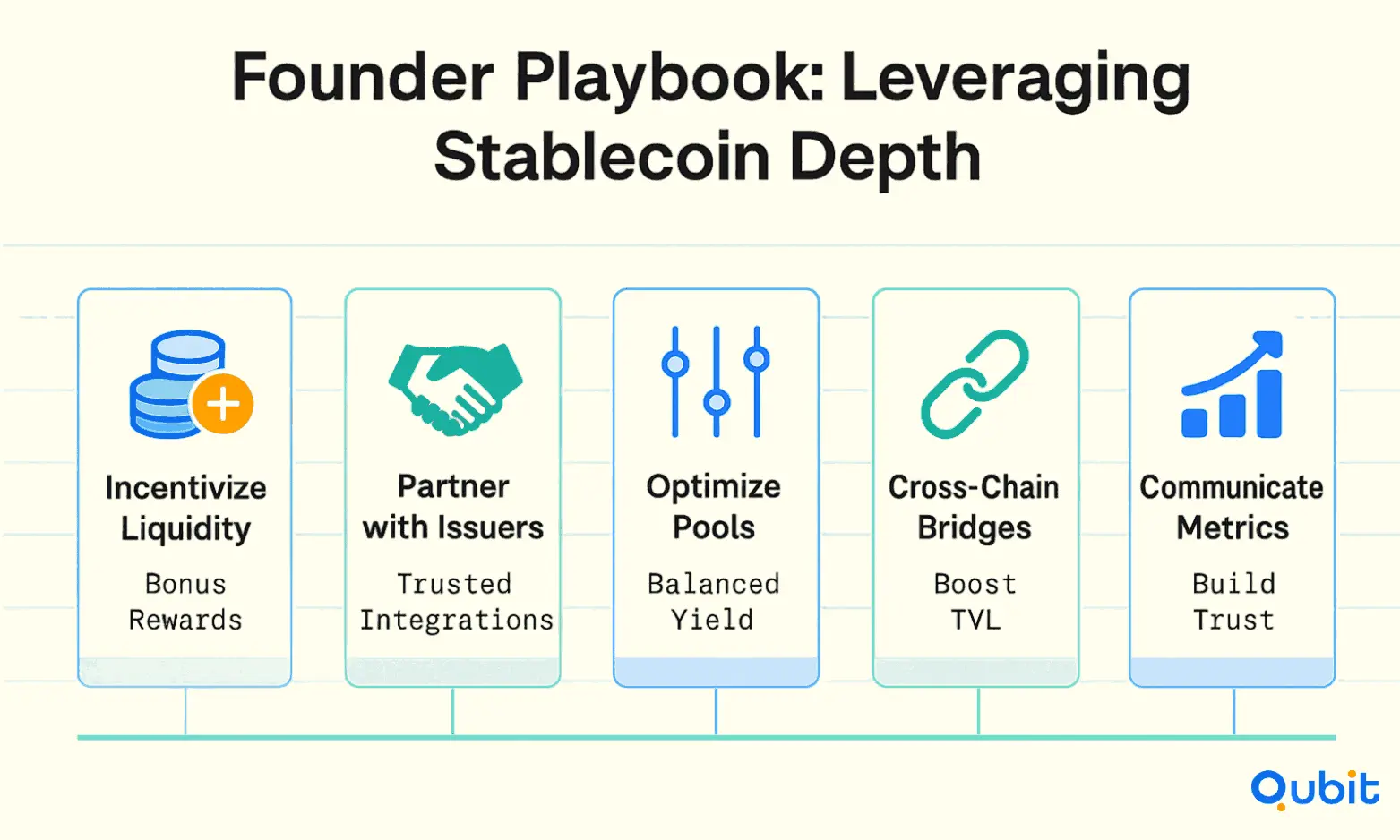The intersection of stablecoins and liquidity pools has become a defining feature of the modern blockchain ecosystem. For startup founders, understanding how these mechanisms influence project valuations, capital flows, and long-term sustainability is now essential, not just for DeFi-native ventures, but for any company building in the digital asset space. As the market matures, the relationship between stablecoins, liquidity, and valuation is evolving in complex ways that present both opportunities and challenges.
You gain an overarching perspective on how the interplay between stablecoins and liquidity pools guides broader funding landscapes, as illustrated by blockchain startup fundraising strategies.
This article explores the mechanics of stablecoins and liquidity pools, their role in valuation dynamics, and the broader implications for DeFi liquidity.
Let’s jump right in!
The Role of Stablecoins in the Crypto Economy
Stablecoins, cryptocurrencies pegged to stable assets like the US dollar, have emerged as the backbone of digital asset markets. Their lack of price volatility makes them ideal for use as a medium of exchange, a store of value, and a bridge between traditional finance and crypto. For founders, stablecoins offer a practical tool for payments, payroll, and cross-border transactions, as well as a critical source of liquidity for decentralized finance (DeFi) protocols.
- Stablecoins underpin much of the activity within DeFi, centralized exchanges, and cross-border payments, providing reliable liquidity and facilitating seamless trading and lending.
- In regions with unstable local currencies, stablecoins are rapidly gaining traction as a hedge against inflation and a means of accessing global financial services.
- The stablecoin market has grown significantly, now driving over a third of DeFi revenue and powering lending, yield strategies, and decentralized exchanges
Founder Playbook: Leveraging Stablecoin Depth

1. Incentivize Stablecoin Liquidity
Offer stablecoin-specific reward programs (e.g., bonus tokens for USDC LPs) to jumpstart deeper pools. Deeper stablecoin pools reduce impermanent loss concerns and draw long-term capital.
2. Partner with Top Issuers
Integrate directly with high-trust stablecoins (USDC, USDT) to reassure LPs about peg stability. Co-branded marketing with major issuers can unlock onboarding grants or listing incentives.
3. Optimize Pool Composition
Experiment with dual-asset pools (e.g., your token + USDC) to align protocol growth with stable capital inflows. Set pool weights (e.g., 70/30 stablecoin/token) to balance volatility and yield.
4. Leverage Cross-Chain Bridges
Deploy stablecoin pools on Layer 2 or alternative chains with lower fees to attract more LPs. Cross-chain liquidity boosts total TVL across ecosystems, enhancing your aggregate valuation.
5. Communicate Metrics Clearly
Publish weekly TVL, net inflow, and APR reports to your community and investors. Transparent dashboards build trust and signal sustainable pool health.
By executing these tactics, founders can deepen stablecoin liquidity, reduce capital costs, and substantiate higher valuations during fundraising rounds.
Liquidity Pools: The Engine of DeFi
Liquidity pools are smart contract-based reserves of tokens that allow users to trade, lend, or borrow assets without needing a centralized intermediary. By pooling their assets, liquidity providers (LPs) earn fees and, in some cases, additional rewards. Stablecoins are a preferred asset in these pools due to their price stability, which reduces impermanent loss and helps maintain efficient markets.
- As more stablecoin capital is deployed into DeFi, lending markets deepen and decentralized exchanges become more robust, supporting higher valuations for protocols that can capture this flow
- Liquidity pools with stablecoins enable tighter spreads, lower slippage, and greater capital efficiency, making them attractive for both traders and protocols.
Capital Flows, Valuations, and the New Reality for Startups
The influx of stablecoins into DeFi has dramatically increased the sector’s economic capacity. More capital onchain means deeper liquidity, more lending and borrowing activity, and greater participation in yield-bearing strategies. This increased liquidity can drive up protocol valuations by supporting higher trading volumes, tighter spreads, and more reliable revenue streams.
However, the landscape is shifting. Recent data shows that while total stablecoin supply has surged, the average liquidity per token has plummeted, falling by nearly 99% since 2021. This is due to an explosion in the number of new tokens, which has diluted available capital across a wider array of projects.
- The average stablecoin liquidity per token dropped from $1.8 million in 2021 to just $5,500 in March 2025, reflecting a 99.7% decrease.
- This dilution means that simply launching a token and building a community is no longer enough to sustain high valuations or attract ongoing investment.
- Protocols must now prove real demand, sustainable revenue, and user retention to justify their valuations and attract liquidity providers.
Valuation Levers: TVL, Spread & Yield
Total Value Locked (TVL)
TVL measures the aggregate assets deposited in your protocol’s liquidity pools. A higher TVL signals deeper liquidity and stronger market confidence. Investors often use TVL as a baseline multiplier—protocols with $100 m TVL may trade at 0.5–2× TVL, depending on other factors.
Liquidity Spread & Slippage
The spread between bid and ask prices reflects pool efficiency. Tighter spreads reduce trading friction and boost volume, key drivers of fee revenue. Protocols demonstrating <0.5% average slippage attract professional traders and market makers, lifting their valuation multiples.
Yield & Fee Revenue
Yield, the annualized return LPs earn, directly ties to protocol revenue. A protocol earning 10% APR on stablecoin pools generates reliable fee streams, which VCs can discount against risk-adjusted rate thresholds. Higher yields improve the protocol’s forward revenue multiple, translating into richer valuations during fundraises.
Risks and Fragilities: What Founders Must Watch
While stablecoins and liquidity pools offer powerful tools for growth, they also introduce new risks that can impact valuations and project sustainability.
- Depegging and Reserve Risk: Stablecoins are only as strong as their underlying reserves and peg mechanisms. If reserves are impaired, or if a stablecoin loses its peg (as seen in high-profile failures), valuations can collapse and liquidity can evaporate.
- Counterparty and Operational Risk: Centralized stablecoins depend on the solvency and integrity of their issuers. Legal, regulatory, or operational issues can threaten the stability and value of these assets.
- Liquidity Crunches: In times of market stress or regulatory uncertainty, liquidity can dry up, causing spreads to widen and valuations to fall. Protocols with unclear governance or reserve structures are especially vulnerable.
- Regulatory Headwinds: As stablecoin issuance grows, regulators are increasingly focused on their reserve management and systemic impact. Regulatory changes could affect liquidity, capital requirements, and the overall attractiveness of stablecoins as collateral
To explore how liquidity pools integrate into broader DeFi funding strategies, refer to DeFi funding models for deeper insights into financing methods that utilize liquidity protocols.
Strategic Considerations for Startup Founders
Given these dynamics, startup founders should take a strategic approach to leveraging stablecoins and liquidity pools:
- Focus on Sustainable Demand: In a capital-constrained environment, protocols must demonstrate clear utility, recurring revenue, and strong user retention. Short-term incentives like airdrops or yield farming may attract initial attention but rarely translate into lasting value.
- Design for Resilience: Ensure that your protocol’s reliance on stablecoins and liquidity pools is backed by robust risk management, transparent reserve structures, and contingency plans for market volatility or depegging events.
- Engage with Regulation: Stay ahead of regulatory developments and build compliance into your product from day one. Clear legal frameworks and transparent governance can help attract institutional capital and foster trust.
- Optimize for Capital Efficiency: Use stablecoins to deepen liquidity and enable efficient trading, but avoid over-reliance on short-term incentives. Explore partnerships, cross-chain integrations, and innovative fee models to attract and retain capital.
- Measure and Communicate Value: Track and report key metrics such as liquidity depth, trading volume, revenue, and user retention. Transparent, data-driven communication with your community and investors is critical for sustaining valuations in a competitive market
For insights into how institutional players influence liquidity pools, explore institutional DeFi investment.
Conclusion
Understanding stablecoin and liquidity dynamics requires a clear narrative that ties together strategies and insights. Throughout this blog, we’ve explored the importance of stablecoins in financial ecosystems, the mechanisms that drive liquidity, and the critical role of transparency in fostering trust. By focusing on these elements, businesses can better position themselves to adapt to evolving market conditions and optimize their financial operations.
A narrative-driven approach not only simplifies complex concepts but also empowers decision-makers to make informed choices. Whether you're a startup or an established entity, prioritizing clarity and strategic planning is essential for long-term success in this space.
If you're looking to secure the right funding, we at Qubit Capital can help with our Fundraising Assistance service. Contact us to learn more and take the next step toward achieving your financial goals.
Key Takeaways
- Liquidity is crucial for effective DeFi operations and minimizing trading risks.
- Automated market makers and yield farming play pivotal roles in driving liquidity.
- Stablecoins contribute to price stability and mitigate volatility in decentralized finance.
- Security challenges such as impermanent loss demand proactive risk management.
- Institutional participation is reshaping liquidity dynamics through increased capital inflows.
Frequently asked Questions
What is liquidity funding in DeFi?
Liquidity funding in DeFi refers to the process of contributing assets to liquidity pools, which are essential for maintaining stable market prices and enabling seamless trading. Participants are rewarded for their contributions, often through token incentives or fees generated by the pool.


 Back
Back



